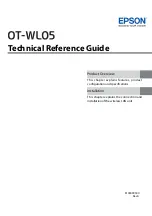
7
Cautions Regarding Security
Notes on Security when Using Wireless LAN
(Important information on customer rights (maintaining privacy))
The advantage of using a wireless LAN over a LAN cable is that, because information is exchanged using
radio signals, you can easily connect to the network if you are within range of the radio signals. A
disadvantage of this is that within a certain range, the electromagnetic signals can pass through barriers
such as walls, so that if security countermeasures are not implemented in some way, problems such as the
following may occur.
Communicated data can be intercepted
A third party may be able to receive wireless transmissions without authorization, and they could obtain
personal information from these transmissions such as IDs, passwords, or credit card numbers, or they
could intercept the contents of personal e-mail messages.
Unauthorized access to the network
A third party could access an individual or intra-company network without permission and carry out any of
the following activities.
Retrieve personal data or other secret information (information leakage)
Pose as another user and send inappropriate data (impersonation)
Overwrite the contents of intercepted data and resend it (falsification)
Introduce a computer virus which could cause data loss or system crashes (damage)
Initially, the possibility that such problems could occur through settings concerning the security of the
wireless LAN product and by using the product are decreased, because the wireless LAN card and the
access point have security measures to deal with these problems. We recommend that you use this product
after making security settings using your own judgment and assuming full responsibility, and with your full
understanding of problems that may occur if you do not make any security settings.
Notes on Setting SSID (Service Set Identifier)
For protection of security, note the following precautions when setting the SSID.
Change the SSID from the default setting.
Do not set texts by which the owner can be identified as the SSID.
Notes on Setting Cryptographic Key
For protection of security, note the following precautions when setting the cryptographic key.
Avoid using words on a dictionary as practicably as possible.
Combine meaningless alphanumeric characters and symbols.
Use texts consisted of at least 13 characters or more or of 20 characters or more if possible.





































